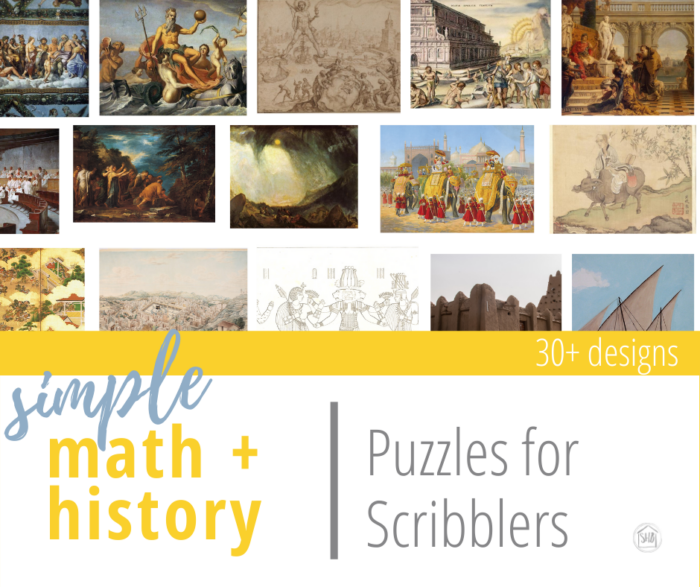
Six years ago, we started our journey with homeschooling with Classical Conversations and we have appreciated it more with each passing year. I love the community it provides my family, the encouragement to keep going in the homeschooling journey, and the resources to help me reach my kid at the stage of learning he is in.
My little guy skips through his life, sort of undefinable. He doesn’t fit into any of the boxes I have previously known in homeschooling our older girls. The beneficiary of years of learning by immersion, he is settling into the songs and chants of CC, working on memorizing them right alongside his older sisters. He started reading before he began “homeschooling” officially. His math skills reached well beyond first-grade math when we brought him into our one-room schoolhouse at 4.
I found myself having to sit down to define kindergarten for our homeschool. Having defined it, I realized he had already surpassed all my kindergarten expectations. But – and this is a big but – he couldn’t write. He didn’t have the fine motor strength for it. Additionally, he wasn’t interested in writing at all.
This post may include affiliate links. If you click and make a purchase based on my recommendation, I get a small remuneration at no extra expense to you. I only recommend things I use and believe to be a blessing.
Homeschooling our Scribbler
To solve the “how to homeschool a Scribbler who isn’t even interested in scribbling” problem, I did what I always do when I run into a wall with homeschooling. I stepped back and observed him. Looking for ways to keep him engaged in learning whilst we are “doing school,” I watched the things he gravitated to. The goals of my observations were to reach him where he is at and still make learning fun and simple.
In my observations, I noticed he is a builder and a puzzler by nature. He plays with building blocks my older girls played with for years in ways I have never seen! Regularly I am shocked when I walk by one of his creations. Building pyramids, 2-D and 3-D, rocketships, towers, castles, his brain is operating on some level I don’t know anything about.
I also started to notice how quickly and how often he was completing the kid puzzles we have. He was way past the age levels on the boxes. People, knowing he was interested in puzzles, would give him 48-piece puzzles which would be completed in mere minutes and then pulled apart and put back together countless times in an afternoon. We moved him up to bigger puzzles – 100 pieces, 250 pieces, 300…up to 750. Being a puzzler myself, I knew the “proper” way to put a puzzle together – borders, big picture, empty space. My little guy does not work this way. It is almost as if the puzzle pieces go from being completely separate to being a puzzle with absolutely no rhyme or reason.
My Scribbler Resource
Having observed this little brain at work, I set about creating some simple resources just for him – puzzles! Last year I created the first set for him and he is still playing with them. Even though they are only 15 piece puzzles, some of them are challenging enough for him to ask for help – a rarity! Over the year, he has gotten used to the skip counting songs from CC, and we can always join each other in a hearty reminder to help with the puzzles.
Because they were so valuable to us last year, I created a resource specifically for him again this year – CC Cycle 1 Math + History Puzzles.
He has loved them so much. Typically, he will sit next to me whilst I do my early morning Bible study and build the puzzles. They are perfect for him because he can either skip count to help put together the picture or use the picture to help him figure out the skip count. And I am always close by to help him when he needs it.
Math + History + Art
I snuck in some other learning opportunities with these puzzles, too! Since they correlate to the history sentences for Classical Conversations Cycle 1, there are 31 puzzles related to the 24 History sentences and some Timeline events!
The way the math memory work is structured for CC, the students learn two skip counts per week until week 6, and then one skip count per week until week 11. After that, there are various measurements and geometry rules, followed by some math laws. Although I couldn’t figure out how to create puzzles in this format using the measurements and geometry rules, I even snuck the math laws into the puzzles! If you are looking for a resource working with the measurements, I have another resource available here.
These puzzles also feature some seriously beautiful works of art and photography! I am so happy with how they turned out. Here’s the master list of artwork included in the set of puzzles:
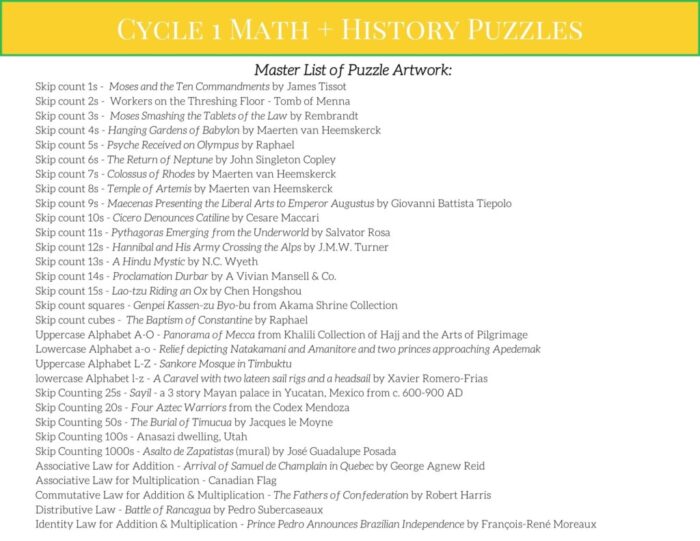
And here are is the Glossary of Images, also included in the set.
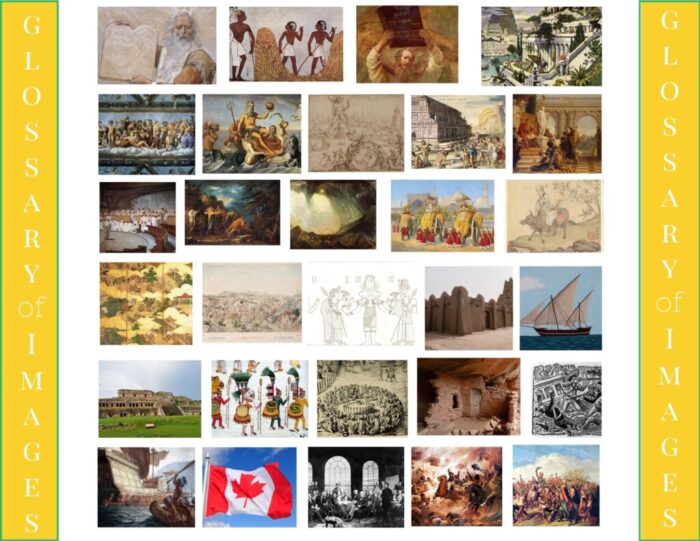
Printing Tips for Math + History Puzzles
I learned a lot when I went to print these out. Wanting them to be durable enough to be used over and over, I used the CC discount to have them printed at Office Depot on heavy white cardstock. But I wanted to make them a bit more durable. Once I got them home, I used my home laminator and some scrap construction paper to laminate the tops of the puzzles (like the ones you buy at the store!).
Here’s the instructions for laminating them on the front.
- Cut the borders of each puzzle, leaving a simple rectangular puzzle.
- Place the puzzle, face up, on top of a scrap piece of construction paper.
- Open a laminating sleeve and tear at the seam, creating two separate laminating sheets.
- Cut each laminating sheet just a bit larger than the puzzle and place it on top of the front of the puzzle.
- The resulting “sandwich” will be top – laminating sheet; middle – puzzle; bottom – construction paper.
- Send the set through the laminating machine.
- Once it has gone through the machine, cut the construction paper border from around the puzzle, leaving the original (now laminated) puzzle.
Isn’t it genius!?! I just love coming up with a way to make durable, professional resources for my homeschool. For more of my genius tips for homeschool printing, read this article.
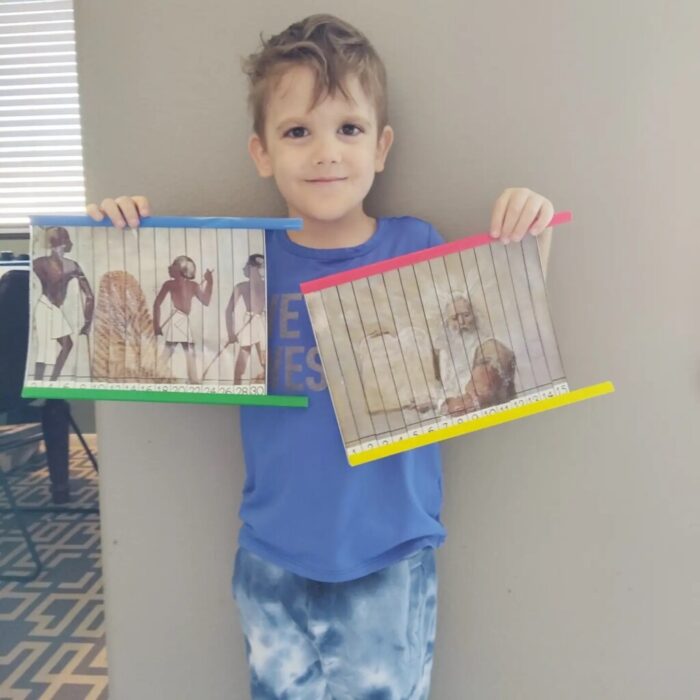
How we Use the Math + History Puzzles
Truth be told, all my kids are interested in these puzzles. But they are perfect for my guy at his early age.
When he needs a little bit of help, I use my skip counting tricks to help him along. We sing the song, we find the next number together, we start over again and end up singing the skip counts over and over until the puzzle is done. It is just a simple little project, which delights us!
The puzzles are meant to help cross the subject areas. The math helps create the picture and the picture reinforces the math.
When he is finished with the puzzle, we talk about the picture. Doing a little art study, practicing noticing. Then we talk about the songs we know from our history memory work or the Timeline. It is such fun to have a song in our hearts as we walk through our days!
If we want to hold it together for a little while, we slide the pieces into two clipbars (the ones found in these report covers), top and bottom. This is a fine motor activity in its own right, which my little guy needs. We can complete the puzzle during our math memory work review at the beginning of the week. Then hang the artwork in our classroom (using a clothesline and clothespins) to look at throughout the week!
We have had so much fun so far this year with these! I hope you and your little learners will, too! Our Math + History Puzzles are available in our Shop.
More Scribbler Resources
If you are interested in more information about how we are “homeschooling” our Scribbler, please check out these articles and resources:
- Simple PAL Learning – how we teach our kids to read
- Fine Motor Skills for Writing – Our Reluctant Writer – how we worked with our reluctant writer
- Simple Reading Resources
- Charlotte Mason in our Classical Homeschool
- Skip Counting Tips and Tricks
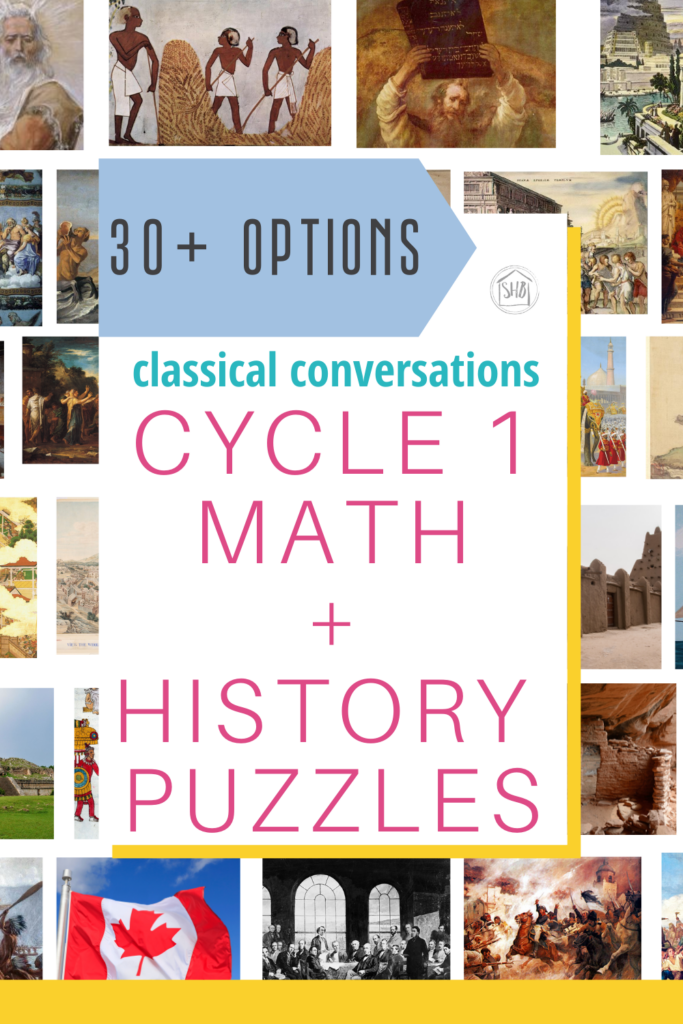




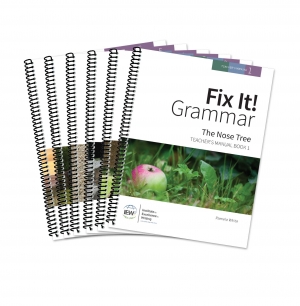
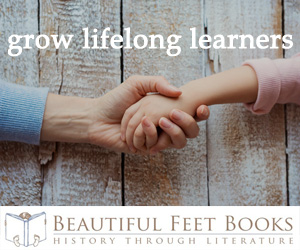
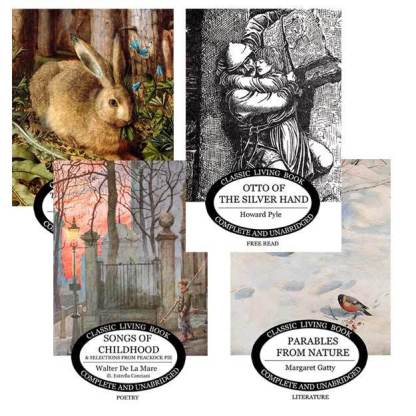
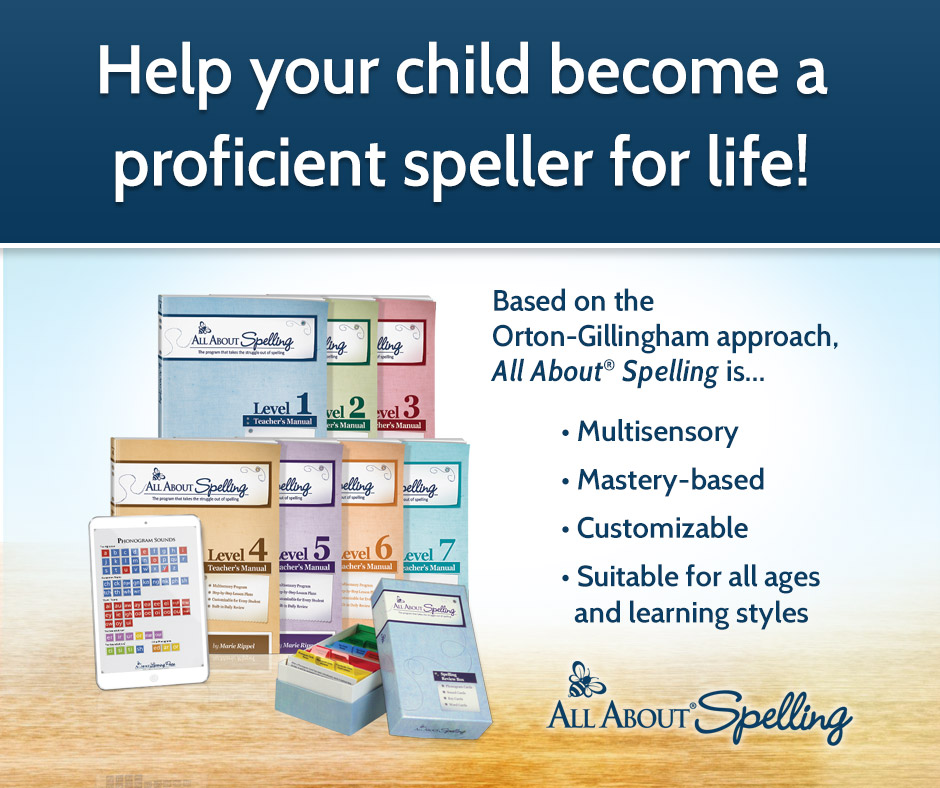


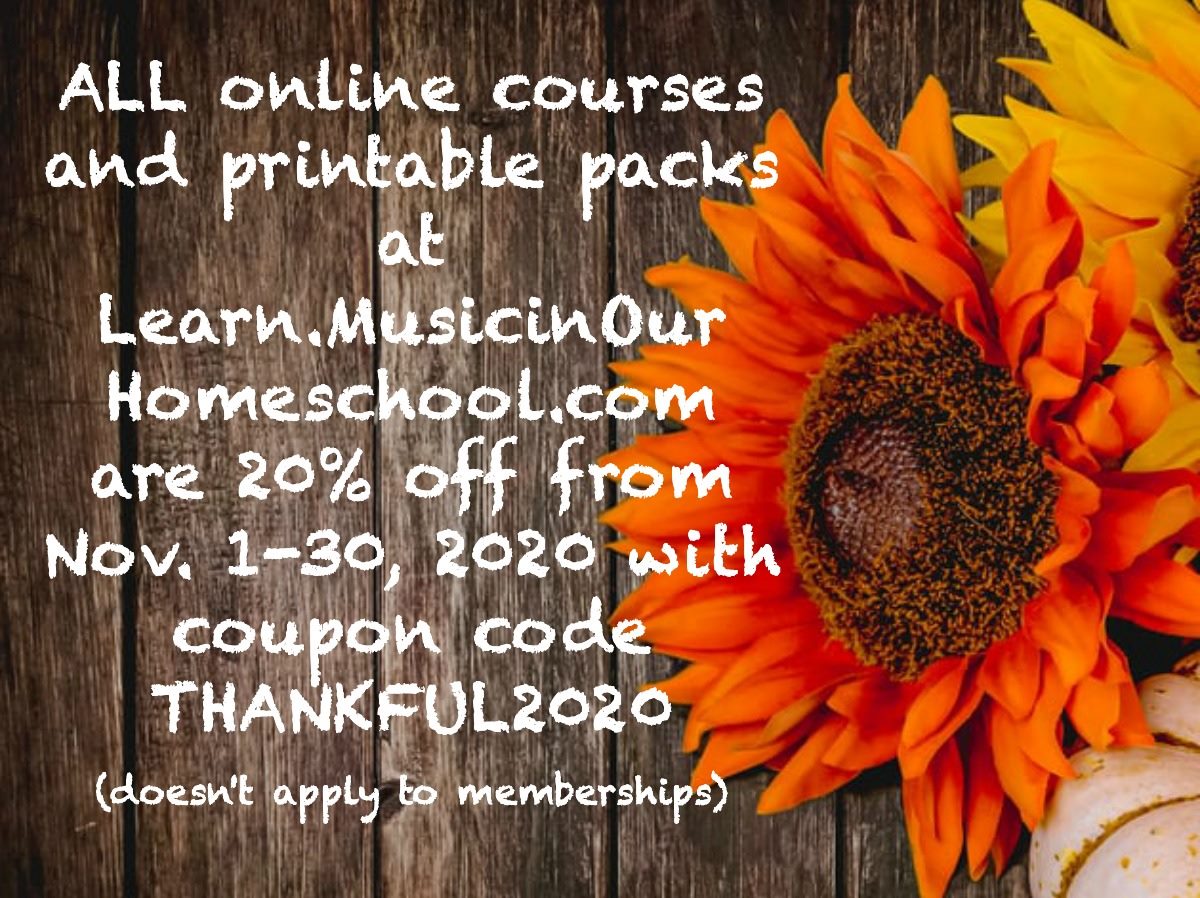
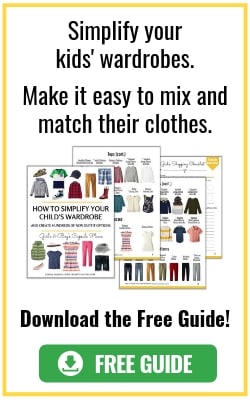


This Post Has 2 Comments
These puzzles sounds like such a cool idea! And the artwork is beautiful. We are entering our 2nd year in CC. My question if I were to make these is, do the pieces slip around being laminated paper making it frustrating to piece together and view when finished? I would love to see a photo of yours completed. Thanks!
Hi, My little guy loves them. Since they are only laminated on the front of the sheet (see my printing instructions), the back lays flat nicely on the puzzle-building surface. We hold them together for extended periods of time with the clips from report covers. Here’s a link to a picture: https://www.instagram.com/p/CT3olJarIdV/?utm_source=ig_web_copy_link